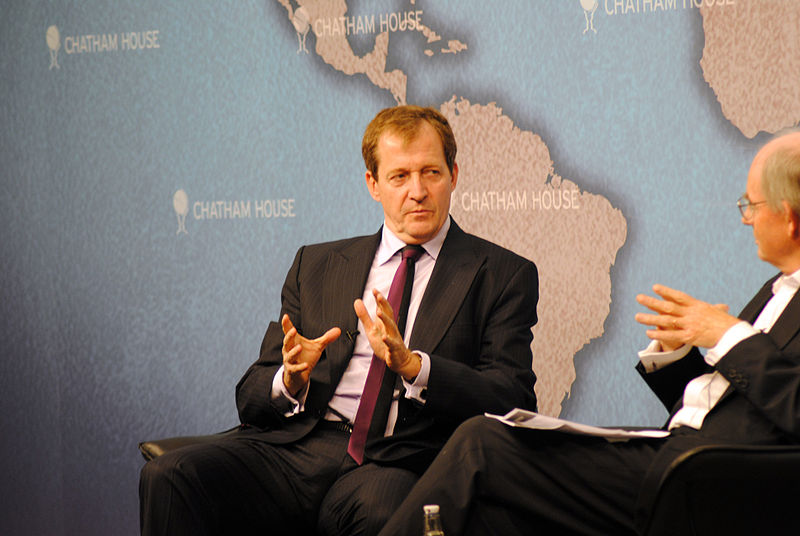Junior ministers during the New Labour years tended to enjoy more than just a ‘view from the foothills’
Chris Mullin’s celebrated series of published diaries revolve around his time as a junior minister, and make frequent references to his insignificance in the role, a perspective which has shaped much understanding of the various Ministerial rungs below Cabinet level. Here, Judi Atkins, Kevin Theakston, and Mark Gill argue that though this characterisation is pervasive, it does not tell the whole story, with the New Labour years showing a number of interesting developments in this regard.
The diaries of the former Labour MP Chris Mullin have heavily influenced views about the role and significance of junior ministers in modern British government. Giving his ‘view from the foothills’ as a junior minister in three departments (Environment, Transport and the Regions and then International Development 1999-2001, followed by the Foreign Office 2003-05), Mullin complained about the low-level drudgery, his complete lack of influence, and the absence of team working in government. Taking Mullin’s diaries as a starting-point, we analysed junior ministers’ appointments and promotions from 1997 to 2010 in order to bring out the patterns of continuity and change in ministerial career paths. Here, we identified three important developments: the emergence of a fast-tracked ‘golden circle’ of favoured and rapidly-promoted ministers, the appointment of more outsiders brought into government through the Lords, and an increased ‘ministerial churn’.
There was a strong sense in the Labour years of a favoured group of younger politicians with a ‘fast track’ route to preferment and senior jobs. One junior minister we interviewed referred to himself as one of the ‘non-golden circle’ MPs eventually given a chance and brought into government. But historically in British government many junior ministers are seen as placemen and not expected to rise further, and the high-flyers have always started climbing the ladder younger than those who do not make it – and the Labour years were no different in that respect. The average age on first junior-minister appointment of those who went on to become Cabinet ministers in the Labour government was 45, compared to 49 for those who did not get that far (49 being the average age on appointment to the Cabinet for those junior ministers who reached it).
As many as 26 per cent of those later promoted to the Cabinet were first made junior ministers under the age of 40, compared to 15 per cent being over 50 at the time of their first appointment. When Gordon Brown promoted James Purnell (age 37), Andy Burnham (38) and Yvette Cooper (38) to the Cabinet in 2008, a host of competent middle-ranking Ministers of State from an older generation knew their chances of reaching the top level had probably gone for good. The Labour years were part of an established pattern whereby anyone coming into politics at 50 years old is a virtual non-starter in the promotion stakes on age grounds alone, so far behind that they cannot catch up.
Brought directly in to the Lords as ‘outsider’ ministers, Brown’s ‘government of all the talents’ (‘GOATs’) initiative attracted a great deal of attention. Although Tony Blair had also appointed some businessmen-outsiders as junior ministers in the Lords, Brown tried it on a slightly bigger scale and to a wider range of posts – albeit with mixed results. Under Brown, appointments included Digby Jones, a business leader, as a trade minister; a surgeon, Lord Darzi, as a junior minister at Health; and businessman Lord Myners as City minister in the Treasury. While Darzi and Myners were widely praised as effective ministers, others found it difficult to adjust to and deal with the political and parliamentary environment, Lord (Digby) Jones leaving after only 16 months, for instance.
The argument that there was too much ‘ministerial churn’ and that Labour’s junior ministers were moved around too quickly was frequently heard. The junior-ministerial turnover in the Labour years was in fact at a faster rate than in the Conservative government 1979-97 (Table 1). As in previous governments there was something of a ‘up or out’ system combined with a fast-moving ministerial merry-go-round. Nearly half of those never making it to the Cabinet held just one post in their ministerial ‘career’ while the Cabinet-bound clocked up more experience (Table 2).
There were variations, however, with some individuals holding just one junior post for two years or less before being promoted to the Cabinet (including Baroness Amos, Ed Balls and Ed Miliband), while at the other extreme it took Ben Bradshaw eight years and five jobs before he reached Cabinet level. Against the criticisms that frequent reshuffles and rapid ministerial turnover undermines the effectiveness of ministers and leads to damaging short-termism is the argument that they have advantages in freshening and revitalising governments, particularly long-serving ones. In the case of junior and middle-ranking ministers in particular, there also remained a strong sense that service in a number of different posts and departments both tested and developed the political and parliamentary skills necessary at Cabinet level.
Table 1: Tenure of junior ministerial posts
| 12 months or less | 13-24 months | 25-36 months | 37-48 months | More than 48 months | |
| Conservative Government 1979-97 | 21% | 34% | 26% | 11% | 8% |
| Labour Government 1997-2010 | 38% | 40% | 14% | 5% | 3% |
Table 2: Number of junior ministerial posts held by Labour ministers 1997-2010
| Number of junior minister posts held | ||||
| 1 | 2 | 3 | 4 or more | |
| Never promoted above junior minister rank | 47% | 20% | 14% | 18% |
| Reaching the Cabinet | 25% | 21% | 30% | 23% |
Another distinctive feature of the Labour years was the number of junior-ministerial ‘retreads’ and ministers who moved down as well as up the normal hierarchy. Six ministers occupied junior minister level posts after serving in the Cabinet (including two – Harriet Harman and Geoff Hoon – who afterwards made it back into the Cabinet). At least another 13 junior and middle-ranking ministers had periods of interrupted service, such as Beverley Hughes (who was brought back a year after resigning as a Home Office minister in 2004) and Lord Hunt of Kings Heath (who resigned in 2003 in protest against the Iraq war but returned to government in 2005). Such (re)appointments have not been unknown in other governments but the larger number of these cases in the Labour government owed something to the Blair-Brown factional divide, a perceived shortage of ministerial talent, a desire to ‘compensate’ ministers forced out of other posts, and party management considerations.
Ultimately, Mullin’s diaries give a colourful but misleading impression of the experience of junior ministers in the Labour government. There were strong continuities from the Thatcher/Major years, but there were also important developments in relation to the emergence of a ‘golden circle’ of favoured and rapidly-promoted ministers, the appointment of more outsiders via the Lords, greater ‘ministerial churn’, and the confirmation of Ministers of State as (usually) ministerial policy-makers with real clout and substance.
—
Note: this post represents the views of the author and not those of Democratic Audit or the LSE. Please read our comments policy before posting. The shortened URL for this post is: https://buff.ly/1qqS5Le
—
 |
Dr Judi Atkins is a Research Fellow in British Politics at the University of Leeds. |
 |
Mark Gill is a Partner at Woodnewton Associates |
 |
Professor Kevin Theakston is a Professor of British Government and Head of the School of Politics and International Studies at the University of Leeds |






 Democratic Audit's core funding is provided by the Joseph Rowntree Charitable Trust. Additional funding is provided by the London School of Economics.
Democratic Audit's core funding is provided by the Joseph Rowntree Charitable Trust. Additional funding is provided by the London School of Economics.
fifa 14 news
Junior ministers during the New Labour years tended to enjoy more than just a ‘view from the foothills’ : Democratic Audit UK
FIFA easports
Junior ministers during the New Labour years tended to enjoy more than just a ‘view from the foothills’ : Democratic Audit UK
fifa 15
Junior ministers during the New Labour years tended to enjoy more than just a ‘view from the foothills’ : Democratic Audit UK
So, @LordPhilofBrum & other junior ministers who return after gaps are known as ‘retreads’ – academics can be cruel
https://t.co/FnLW6qlKsG
Junior ministers during the New Labour years tended to enjoy more than just a ‘view from the foothills https://t.co/Umjs6vFdKV
Junior ministers during the New Labour years tended to enjoy more than just a ‘view from the foothills’ https://t.co/3Ym3ouYuWz
Junior ministers during the New Labour years tended to enjoy more than just a ‘view from the foothills’ https://t.co/8jkC2Ak78G